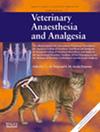The effect of intravenous hydromorphone alone or in combination with midazolam or dexmedetomidine on intraocular pressure in dogs
IF 1.4
2区 农林科学
Q2 VETERINARY SCIENCES
引用次数: 0
Abstract
Objective
To evaluate the effect of intravenous (IV) hydromorphone alone or in combination with midazolam or dexmedetomidine on intraocular pressure (IOP) in dogs.
Study design
Prospective, randomized, blinded, crossover study.
Animals
A group of seven healthy, ophthalmologically normal, adult Beagle dogs.
Methods
A total of four IV drug combinations were evaluated: hydromorphone 0.1 mg kg–1 (H); hydromorphone 0.1 mg kg–1 and dexmedetomidine 0.001 mg kg–1 (HD); hydromorphone 0.1 mg kg–1 and midazolam 0.2 mg kg–1 (HM2); and hydromorphone 0.1 mg kg–1 and midazolam 0.4 mg kg–1 (HM4). Treatment order was randomized, with a 2 week washout period between treatments. IOP and sedation scores were obtained before (T0) and 3, 30, 60, 240 and 480 minutes after drug injection. To account for repeated measurements for each dog across treatments and time points, mixed models were used to compare IOP at T0 by eye and to describe changes from T0 in IOP (averaged across eyes) and sedation scores.
Results
In treatment H, IOP increased significantly from baseline levels [predicted mean increase of 5.5 mmHg [95% confidence interval (CI): 3.7–7.3] at T3 (p < 0.001) and 2.7 mmHg (95% CI: 0.9–4.5) at T30 (p = 0.005)]. In treatment HD, mean IOP increased from baseline by 2.3 mmHg (95% CI: 0.5–4.1) at T30 (p = 0.014). In treatment HM2, mean IOP increased by 2.5 mmHg (95% CI: 0.2–4.9) at T30 (p = 0.035). In treatment HM4, IOP did not change significantly from baseline at any time point. Sedation scores over time did not differ significantly between treatments.
Conclusions and clinical relevance
Injection of IV hydromorphone alone (0.1 mg kg–1) caused a transient increase in IOP and might not be appropriate if an acute increase in IOP is undesirable. Addition of dexmedetomidine or midazolam to hydromorphone, at the doses studied, appears to attenuate this increase in IOP.
单用氢吗啡酮或联用咪达唑仑或右美托咪定对犬眼压的影响。
目的:评价氢吗啡酮单用或联用咪达唑仑、右美托咪定对犬眼压的影响。研究设计:前瞻性、随机、盲法、交叉研究。动物:一组7只健康、眼科正常的成年比格犬。方法:对四种静脉联合用药进行评价:氢吗啡酮0.1 mg kg-1 (H);氢吗啡酮0.1 mg kg-1,右美托咪定0.001 mg kg-1 (HD);氢吗啡酮0.1 mg kg-1,咪达唑仑0.2 mg kg-1 (HM2);氢吗啡酮0.1 mg kg-1,咪达唑仑0.4 mg kg-1 (HM4)。治疗顺序随机化,两次治疗之间有2周的洗脱期。分别于用药前(T0)和注射后3、30、60、240、480 min进行IOP和镇静评分。为了解释每只狗在不同治疗和时间点的重复测量,使用混合模型来比较T0时每只眼睛的IOP,并描述从T0开始IOP(双眼平均)和镇静评分的变化。结果:在H治疗组,IOP较基线水平显著增加[预测T3时平均增加5.5 mmHg[95%可信区间(CI): 3.7-7.3] (p < 0.001), T30时平均增加2.7 mmHg (95% CI: 0.9-4.5) (p = 0.005)]。在HD治疗组,T30时平均IOP较基线增加2.3 mmHg (95% CI: 0.5-4.1) (p = 0.014)。在HM2治疗组,T30时平均IOP增加2.5 mmHg (95% CI: 0.2-4.9) (p = 0.035)。在HM4治疗组,IOP在任何时间点与基线相比均无显著变化。镇静评分随时间的变化在两种治疗之间没有显著差异。结论和临床意义:单独静脉注射氢吗啡酮(0.1 mg kg-1)可引起短暂性IOP升高,如果不希望急性IOP升高,则可能不合适。在研究的剂量下,将右美托咪定或咪达唑仑添加到氢吗啡酮中,似乎可以减弱IOP的增加。
本文章由计算机程序翻译,如有差异,请以英文原文为准。
求助全文
约1分钟内获得全文
求助全文
来源期刊

Veterinary anaesthesia and analgesia
农林科学-兽医学
CiteScore
3.10
自引率
17.60%
发文量
91
审稿时长
97 days
期刊介绍:
Veterinary Anaesthesia and Analgesia is the official journal of the Association of Veterinary Anaesthetists, the American College of Veterinary Anesthesia and Analgesia and the European College of Veterinary Anaesthesia and Analgesia. Its purpose is the publication of original, peer reviewed articles covering all branches of anaesthesia and the relief of pain in animals. Articles concerned with the following subjects related to anaesthesia and analgesia are also welcome:
the basic sciences;
pathophysiology of disease as it relates to anaesthetic management
equipment
intensive care
chemical restraint of animals including laboratory animals, wildlife and exotic animals
welfare issues associated with pain and distress
education in veterinary anaesthesia and analgesia.
Review articles, special articles, and historical notes will also be published, along with editorials, case reports in the form of letters to the editor, and book reviews. There is also an active correspondence section.
 求助内容:
求助内容: 应助结果提醒方式:
应助结果提醒方式:


